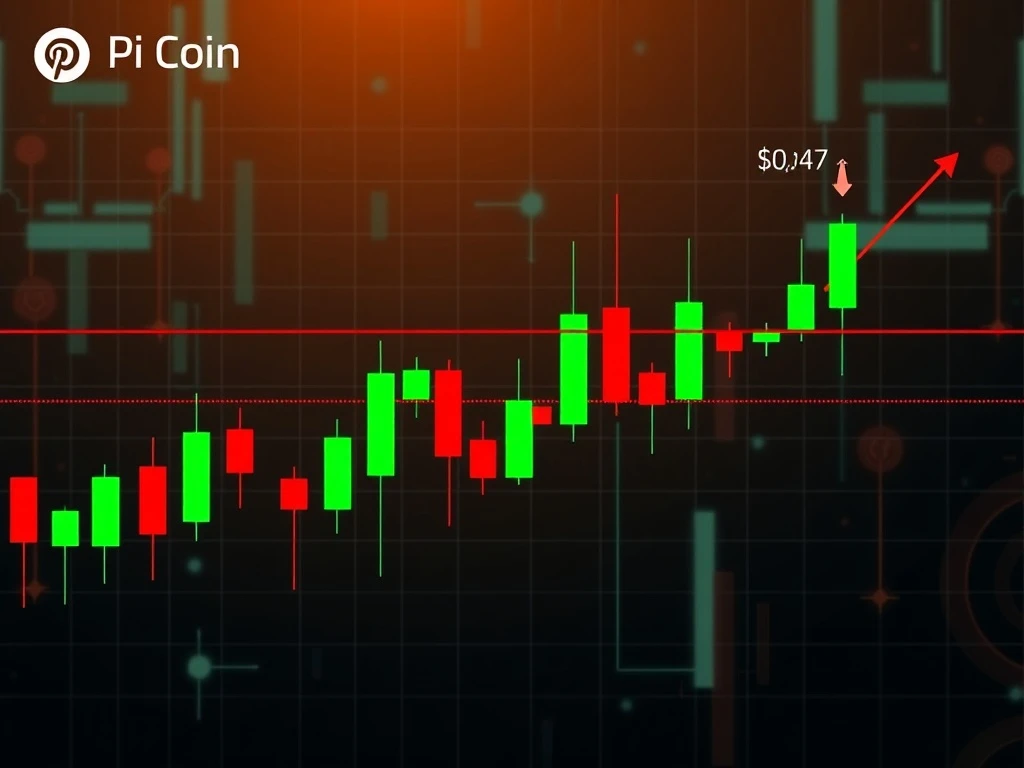Pi Price: Bulls Face Crucial $0.47 Support After Bearish Rejection

The world of cryptocurrency is a constant ebb and flow of excitement and caution. For enthusiasts following the unique journey of Pi Network, recent developments have brought a mix of anticipation and concern. Despite the announcement of two major features, the Pi price has struggled to find bullish momentum, leaving many wondering: what’s next for this promising altcoin?
Pi Coin Update: Why Did New Features Fail to Ignite Momentum?
In the fast-paced crypto landscape, news often dictates market sentiment. Last Friday, the Pi Network community received an exciting Pi coin update: the release of two significant features. Historically, such announcements can act as catalysts, driving prices upward as investor confidence and interest surge. However, the market reaction to Pi’s news has been counter-intuitive, with the price turning bearish after an initial positive run.
- Anticipation vs. Reality: Leading up to the announcement, there was some positive price action, suggesting market participants were front-running the news. However, once the features were revealed, the expected surge didn’t materialize.
- Market Dynamics: This indicates that either the features didn’t meet market expectations for significant utility or adoption, or broader market conditions are exerting stronger downward pressure.
- Seller Dominance: The immediate bearish turn suggests that many investors used the news as an opportunity to sell, rather than buy, leading to a decline in price momentum.
This situation highlights a common challenge in crypto markets: even positive news isn’t a guaranteed recipe for price appreciation if underlying market sentiment or the perceived impact of the news doesn’t align with investor expectations.
Decoding Pi Price Prediction: Key Levels to Watch
To understand the current state and potential future trajectory of Pi, a deep dive into its chart is essential. The Pi price prediction hinges on identifying critical support and resistance levels that define the battleground between buyers and sellers.
On Wednesday, Pi saw a brief surge, rising above the 20-day Exponential Moving Average (EMA) at $0.56. This was a hopeful sign for bulls, indicating potential recovery. However, this optimism was short-lived as buyers failed to overcome the overhead resistance at the 50-day Simple Moving Average (SMA), positioned around $0.66. The 20-day EMA and 50-day SMA are crucial technical indicators that traders use to gauge trend direction and potential support/resistance areas. The 20-day EMA reacts more quickly to price changes, while the 50-day SMA provides a broader view of the trend.
Following this rejection, the price turned downwards, closing below the 20-day EMA on Thursday. This action signaled a renewed dominance by bears, pushing Pi back into a precarious position. Currently, two key support levels are in focus: $0.47 and, if that breaks, $0.40. These levels represent points where historical buying interest has emerged, potentially halting further declines.
Navigating Crypto Market Analysis: Bulls vs. Bears at $0.47
The current landscape for Pi is a classic example of the ongoing tug-of-war in crypto market analysis. The $0.47 level has become a pivotal point where bulls are making a stand against persistent bearish pressure.
While the moving averages are sloping downwards, indicating a bearish trend, there’s a glimmer of hope in the Relative Strength Index (RSI). The RSI, a momentum oscillator, is showing early signs of forming a positive divergence. This occurs when the price makes a lower low, but the RSI makes a higher low, suggesting that the selling momentum is weakening, and a potential rebound could be on the horizon. This divergence often precedes a price reversal, offering a cautious bullish signal.
What happens if the $0.47 support holds? If the Pi price rebounds strongly from $0.47 and manages to climb back above the 20-day EMA, it would indicate that buyers are stepping in at lower levels, seeing value in the current price. Such a move would be a significant win for the bulls, potentially paving the way for a test of higher resistance levels.
Conversely, if the bears manage to push the price decisively below $0.47, the selling pressure could intensify, leading to a further drop towards the next support at $0.40. A breakdown of critical support levels often triggers stop-loss orders, accelerating the downward movement.
Understanding Support and Resistance: The $0.66 Hurdle
Beyond the immediate support at $0.47, the $0.66 level stands as a formidable barrier, acting as a strong resistance point. Understanding support and resistance levels is fundamental to technical analysis, as they highlight areas where supply and demand dynamics are expected to shift. The 50-day SMA at $0.66 has proven to be a tough ceiling for Pi’s price action.
Looking at the 4-hour chart provides a more granular view of the immediate price action. Here, the 20-EMA is clearly sloping down, and the RSI is near the oversold territory. This reinforces the narrative that bears are firmly in control in the short term. Buyers will likely attempt to initiate a relief rally from $0.47. However, this rally could face significant selling pressure as it approaches the downward-sloping 20-EMA on the 4-hour chart. If the price turns down sharply from this 20-EMA, it would increase the risk of a break below $0.47, potentially leading to a slide towards $0.40.
However, if bulls demonstrate strength and manage to break above the 20-EMA on the 4-hour chart, it would signal a potential comeback. While the 50-SMA on this shorter timeframe would still pose resistance, a successful breach could see the pair climb towards $0.60. A sustained move above $0.66 would be a major victory for the bulls, indicating a shift in momentum and potentially opening the doors for a stronger recovery.
What’s Next for Altcoin Price Action? Actionable Insights
For those invested in Pi or considering it, monitoring these levels is crucial. The current altcoin price action for Pi reflects a market in search of direction, heavily influenced by key technical thresholds.
Key Takeaways for Traders and Investors:
- Watch $0.47 Closely: This is the immediate battleground. A strong bounce suggests buying interest at lower levels. A decisive break below could signal further downside.
- Monitor RSI Divergence: If the positive divergence on the RSI strengthens, it could be an early indicator of a potential trend reversal.
- The $0.66 Hurdle: A sustained move above $0.66 is necessary for Pi to establish a clear bullish trend. Until then, any rallies may be considered relief rallies.
- Risk Management: Given the current bearish sentiment, employing sound risk management strategies, such as setting stop-losses, is vital.
- Stay Informed: Keep an eye on broader crypto market trends and any further announcements from the Pi Network, as these can significantly influence price.
It’s important to remember that the cryptocurrency market is highly volatile. Every investment and trading decision carries inherent risks. Always conduct your own thorough research and consider your financial situation before making any investment choices.
Conclusion: Pi’s Path Forward: A Test of Resilience
The recent price action for Pi Network serves as a stark reminder that even anticipated positive news doesn’t always translate into immediate price gains. The market’s rejection of a breakout and the subsequent bearish turn highlight the importance of key technical levels. The immediate future of Pi price hinges on the $0.47 support. If bulls can successfully defend this level, it could set the stage for a recovery attempt towards the critical $0.66 resistance. However, a failure to hold $0.47 could see Pi exploring lower price territories. As always, the dynamic interplay between market sentiment, technical indicators, and fundamental developments will ultimately dictate Pi’s journey in the challenging crypto landscape.








